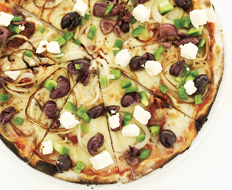Of pizza, french fries, and ice cream, it is often said, “The worst I ever had was still pretty good.”
The cynical entrepreneur might therefore conclude that one could serve subpar versions of all three items and still retain some sort of customer base, if one were inclined to cut corners. But—far more enticingly for you, my quality-conscious friends—this sentiment also suggests that even a little discretionary effort can make a major difference when it comes to foods with widespread and deep-rooted appeal.
Let’s take pizza as our example. It may seem, at this stage in the product’s evolution, that anything you could possibly think to do has been done to Naples’ most notable culinary export. Given that there are just four variables to work with—crust, sauce, cheese, and toppings—and that thousands of creative variations have already been spawned by chefs and home cooks looking to monkey with convention, what are our options?
Creative Crusts − For most of us, crust can make or break a pie. Feed a wafer-thin flatbread-style crust to a Sicilian-style aficionado and you’ll send him racing straight back to his traditional pizza haunts. Serve a deep-dish version to a flatbread fan and you’ll be deep-sixed. Operators therefore need to consider the merits of tinkering with thickness, texture, flavor, and nutritional content to arrive at the perfect carrier.
Already, chains such as Uno’s are responding to guests’ desire for healthier offerings with innovations like five-grain, high-fiber, and whole-wheat crusts, including those made with the healthful additives wheat germ, oat bran, sesame seeds, and ground flax seed.
BJ’s, Zpizza, and Boston’s The Gourmet Pizza, meanwhile, have latched onto the gluten-free trend—replacing wheat flour with viable rice, potato, and tapioca substitutes, and finding favor with the celiac community in the bargain. Meanwhile, Naked Pizza, out of New Orleans, boasts “the world’s healthiest” pie, one made with 12 whole grains, nuts, and roots, and fortified with high-grade fiber and heat-resistant probiotics.
Finishing Off Fresh − Like many Bay Area residents, I have a deep and abiding affection for Berkeley, California’s Cheese Board Collective. It’s located in what’s known as the city’s “gourmet ghetto,” and its pizzas generate around-the-block lines of patient pie lovers eager for a taste of something fresh yet familiar. The collective’s emphasis on seasonal ingredients yielded, during one week recently, pies topped with fresh corn, zucchini, Mexican key limes, garlic olive oil, crimini mushrooms, French goat cheese, asparagus, and caramelized onions.
On my past trips to this neighborhood mainstay, I’ve been ecstatic to see the staff taking a brush sopping with garlic, olive oil, lemon juice, and parsley and painting the pie with a fresh finishing touch. The sight of a pizza glistening with this mouthwatering mixture was so tantalizing that it more than justified the long wait. Plus, it’s just the sort of thing any pizza restaurant can offer with a minimum amount of fuss.
Injecting an Artisan Touch − Uniformity, consistency, and predictability have always been cornerstones of quick-serve establishments’ appeal. But in an era when individualized, artisanal foods and flourishes have become de rigueur, pizza is a safe place for experimentation.
While assembly line pizza can be tasty, many consumers have come to associate quality with handmade. So go ahead, consider allowing for hand-tossed dough, unevenly applied toppings and sauces, and other little deviations from the norm to convey a homemade approach.
Signature Spins − With some careful sourcing arrangements, it’s conceivable that quick-serve-pizza operators could add signature or local seasonal ingredients to lend their pies a distinctly regional feel.
There’s burrata cheese, potatoes, pistachios, pine nuts, locally sourced greens, herbs, and tomatoes—the options are endless. And each can be quite enticing for consumers. Having a pie on the menu that simply can’t be had elsewhere would be a novel point of difference for a chain operation.
Ethnic Twists − Look, when you’ve got an oven, refrigerators, and pizza peels, the world is your oyster. Armed with these basic implements, you can take pizza to exotic new places, as many high-end restaurants have done for years.
San Francisco’s Grand Café offers an Alsatian flammenküche—a thin flatbread topped with caramelized onions, lardons, and crème fraîche. Other unusual variants include Oaxacan “pizza” made with a thin tortilla smeared with pork fat, black beans, cheese, lettuce, and meat. Another option is the Armenian lahmajune, consisting of a flatbread crust that’s been covered in ground lamb, tomatoes, and bell peppers, and baked until dark brown.
While it sometimes seems as though the basic pizza formula has been put through its paces, I’d argue that it’s nowhere near exhausted. Indeed, any combination of the above elements could produce pies with enough novel twists and quirks to inspire innumerable repeat visits.
Ladies and gentlemen, start your ovens.











